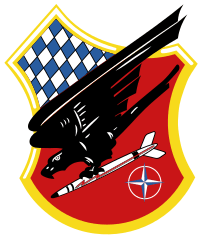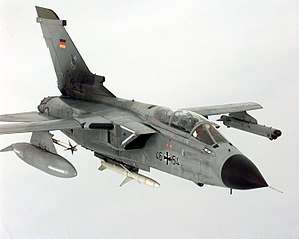Jagdbombergeschwader 32
Jagdbombergeschwader 32 (Fighter-Bomber Wing 32; abbreviated as: JaBoG 32) was a fighter-bomber wing of the German Air Force (Luftwaffe). The wing was based in the south of Germany at Lechfeld Airbase and flew Tornado IDS and Tornado ECR planes in the Suppression of Enemy Air Defenses role.
| Jagdbombergeschwader 32 (Fighter-Bomber Wing 32) — III — | |
|---|---|
 | |
| Active | 22 July 1958- 31 March 2013 |
| Country | |
| Branch | |
| Role | Suppression of Enemy Air Defenses |
| Part of | 1st Air Force Division (1. Luftwaffendivision) |
| Garrison/HQ | Lechfeld Air Base |
| Engagements | F-84 Thunderstreak incident Operation Deliberate Force Operation Allied Force |
| Commanders | |
| Current commander | Colonel Stefan Scheibl |
| Notable commanders | Siegfried Barth |
| Aircraft flown | |
| Attack | Formerly: Republic F-84F Thunderstreak, Lockheed F-104 Starfighter, Panavia Tornado IDS |
| Electronic warfare | Present: Panavia Tornado ECR |
History
The wing was raised during 1957 on Lechfeld Air Base was officially activated on 22 July 1958. Initially equipped with Republic F-84F Thunderstreak fighters, two planes will be buried in the French West Berlin Air Base follows the 1961 F-84 Thunderstreak incident.
The wing began to receive Lockheed F-104 Starfighters during 1965 and the last Thunderstreak left Lechfeld Air Base on 13 July 1966. In 1984 the wing began its conversion to Panavia Tornado IDS strike fighters. In 1991 the wing was equipped with 35 new Tornado ECR fighters and began its new mission as Germany's only suppression of enemy air defenses (SEAD) capable wing.
On 17 July 1995 Tornado ECRs of JaBoG 32 transferred to San Damiano Air Base in Italy, from where they flew SEAD missions in support of NATOs Operation Deliberate Force over Bosnia and Herzegovina. These were the first combat operations for the German Armed Forces since World War II.[1]
From 24 March to 11 June 1999 JaBoG 32 participated in NATOs Operation Allied Force against Yugoslavia. The Tornado ECRs carrying AGM-88 HARM missiles escorted allied aircraft over Yugoslavian territory to neutralize hostile air defense threats. A total of 236 HARM missiles were fired by JaBoG 32 during the campaign.
In 2008 the first German female combat pilot, Ulrike Flender, joined JaBoG 32. In October 2011 the German Federal Ministry of Defence announced a reorganisation/reduction of the German Armed Forces.[2] As a result of this reorganisation, the wing was disbanded on 31 March 2013, with personnel and planes joining the 1st Squadron of Aufklärungsgeschwader 51 (Reconnaissance Wing 51).[3]
References
- Cohen, Roger. "Conflict in the Balkans: Half a Century After Hitler, German Jets Join the Attack." New York Times, 26 March 1999.
- Quoted from Bundesministerium der Verteidigung (26 October 2011), Neues Stationierungskonzept der Bundeswehr (in German), retrieved 5 November 2011, PDF-file "Die Stationierung der Bundeswehr in Deutschland", passim
- "Last Call" (in German). Federal Ministry of Defence. 22 January 2013. Retrieved 14 March 2013.

